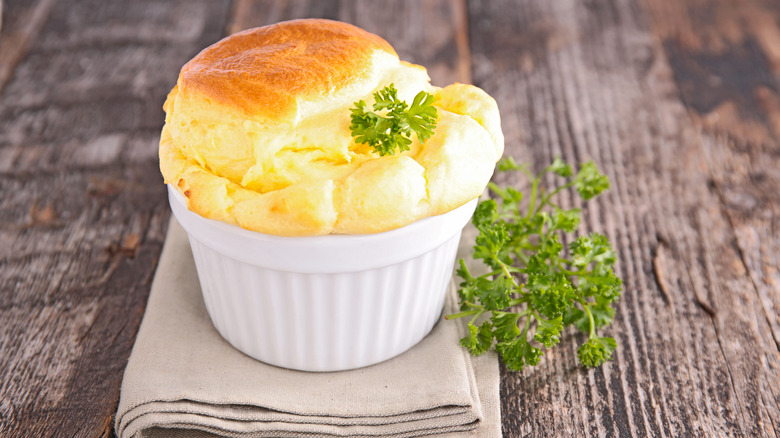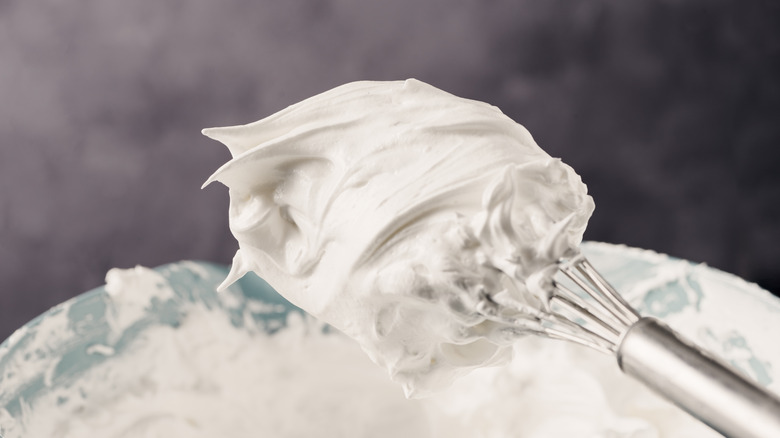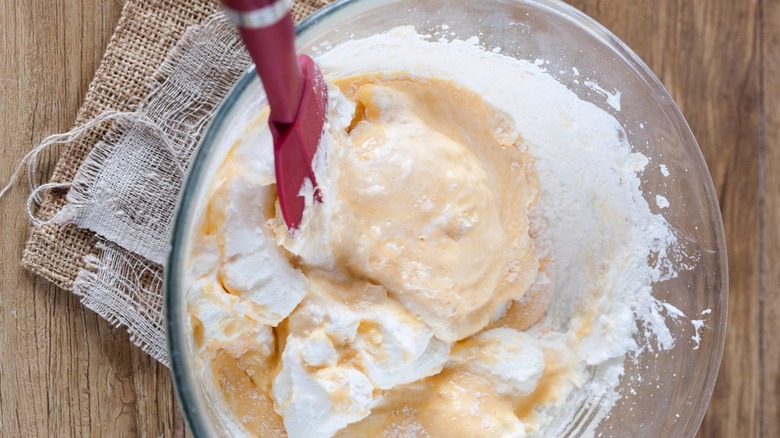The Baking Soda Swap You Need For Lofty, Cloud-Like Bakes
Baking is a science. Therefore, it requires specific ingredients in precise measurements and mixed in a particular way in order to produce the intended yummy goods. It doesn't matter whether you're making a simple cake or a complex soufflé, sticking to a proven recipe is vital for any successful baking venture. However, if you're looking to elevate your baked goods in one way or another, an ingredient swap may be necessary to achieve even better results. For example, for a higher rise or fluffier texture, replacing baking soda with whipped egg whites will do the trick. Since eggs are a kitchen staple, you likely have a few on hand so no need for an impromptu grocery store run.
Both fresh baking soda and whipped egg whites are leavening agents, which means they help baked goods to rise by producing or incorporating air into the dough or batter. This action is very critical in baking since it gives your treats the shape and soft texture you know and love. Beyond the impact on the structure, leavening agents also contribute to the flavor since they are, after all, ingredients like any other in a recipe.
But why go for whipped egg whites instead of baking soda, if both serve the same functions? Well, when prepared and incorporated properly into the batter, beaten egg whites produce a more grand lift on your baked goods because of how it works to bring that rise.
Whipped egg whites are a mechanical leavening agent
Different leavening agents work in various ways. Baking soda, for example, as a chemical leavening agent, relies on the chemical reaction between itself and an acid to produce carbon dioxide, which causes the baked goods to rise. On the other hand, whipped egg whites are a mechanical leavening agent, which means it's the physical manipulation (e.g. whipping) of the ingredient that creates a structure that holds air and inflates the baked items. This type of mechanical leavening is known as foaming.
When you beat egg whites, the protein chains stretch out and form bubbles that collect air as the beating continues. The more you whip the whites, the more bubbles are formed, resulting in a foamy appearance. Once the foamy whites are incorporated in the batter and put in the oven to bake, the heat makes the tiny air cells expand and cause the baked item to rise. Some baked goods that can greatly benefit from whipped egg whites as their leavening agent include sponge cakes, muffins, meringue, baked waffles, and fluffy soufflé. Here's how to do it.
How to add whipped egg whites to baked goods
To swap baking soda for whipped egg whites in your baked goods, start by mixing the ingredients for the batter as usual but minus the baking soda. Next, calculate how many egg whites you'll need to replace the baking soda — this will vary depending on your recipe, however, you can work with a basic ratio of one egg white for every ½ teaspoon of baking soda.
Now separate the egg yolks from the whites, put the whites in a glass bowl, and whisk them thoroughly. If you're using an electric mixer, increase the whisking speed gradually and beat until the whites form soft peaks. Once ready, add the whipped egg whites to the batter mixture by folding them in gently instead of mixing or stirring as we do with other ingredients.
Ensure you get the folding technique right: Use a rubber spatula and slide it down the middle of the bowl as if you're slicing through the batter and whites. Then twist the spatula and take it under the batter and around to the side, lifting the batter and folding it on top of the whites. Turn the bowl a quarter-turn and repeat the folding motion. Do this until the whites are incorporated into the batter. Take care not to overmix to avoid losing all the air you've worked so hard to get into the whites. Finally, proceed with the rest of the recipe as usual and get ready for the loftiest bake.


